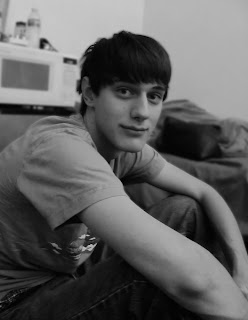In the first image, I wanted to create a contrast that would bring the viewer to focus their eyes on her face and the image on her face. I painted the monarch butterfly on her face with makeup. Her face is off centered and placed at the bottom left of the picture. For lighting I used a lamp and I placed her in front of a dark backdrop.
In the second image, I used a more candid approach and just took pictures as I sat with my subject on the ground. The lighting is indoor lighting, so it does not create a high contrast within the picture. I blurred the background in order to create more of a focus on the subject in the foreground.
For the last photo, I had the subject climb into a tree and sit on one of the branches. The lighting outside was quite dark, so I had to lighten up the photo in order to make it more viewable. The subject is placed off center at the left of the image. The viewer follows the subjects gaze which continues across the page until it leaves the frame. The viewer is left to wonder what the subject is looking at.







